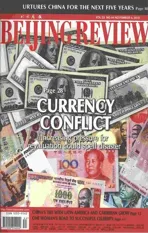A Roadmapfor Five Years
2010-10-16ByLILI
By LI LI
A Roadmapfor Five Years
By LI LI
Proposal for the development plan in the next half decade highlights a competitive economy, people’s livelihoods and a fairer society
T he Communist Party of China (CPC)issued the full text of a proposal that w ill play a crucial role in shaping the country’s development over the next five years on October 27.
The docum ent, the CPC Central Comm ittee’s Proposal on Formulating the 12th Five-Year Program (2011-15) on National Economic and Social Development,was adopted at the Fifth Plenary Session of the 17th CPC Central Committee which ended October 18.
Divided into 12 parts, the proposal provides the basis for drafting the 12th Five-Year Program. It includes accelerating transformation of econom ic development patterns, further expanding domestic demand and pushing forward the modernization of agriculture.
The proposal also stresses development of a modern industrial system, coordinated development of all regions, and the construction of an energy-efficient and environmentally friendly society in the com ing five years.
“Substantial progress shall be made in transform ing the econom ic development pattern; the country’s comprehensive national power, international competitiveness and capability in shielding against risks shall be remarkably strengthened; notable progress shall be made in meeting people’s living and cultural demands,” the document says.
Acceleration of the transformation of the econom ic development pattern was a pro found reform and should proceed throughout all sectors of econom ic and social development, while econom ic strategic restructuring should be a major task in the transformation, according to the proposal.
Economic strategic restructuring requires China to expand domestic consum ption,strengthen agriculture, grow emerging industries of strategic importance and prudently proceed w ith urbanization.
To support the transformation, China should upgrade its capabilities in indigenous research and innovation in science, technology and administration, train more innovative talents, said the proposal.
The “fundamental end” of econom ic transformation was to improve people’s lives, which can only be achieved by giving priority to creating jobs, providing equal public services to every citizen and stepping up reform of the income distribution system,said the proposal.
China w ill increase residents’ property incomes, boost employment, raise m inimum wage standards, ensure worker wages are duly paid and increased as well as enhance the role of taxes in regulating excessive incomes, it said.
In transforming the economic development mode, the importance of building a resource-saving and environmentally friendly society should be stressed to save energy,reduce greenhouse em issions and tackle global climate change.
The country should continue to uphold the public ownership economy as its pillar,while creating an environment that allows all types of ownership equal access to production elements, fair market competition and equal legal protection.
Efforts should be made to deepen reforms in monopoly industries, and to encourage non-state-owned enterprises to participate in the reforms conducted in stateowned companies.
Meanwhile, the document says China w ill “nurture and develop seven new strategic industries w ith favorable policies during the next five years.”
The industries are new-generation information technology, energy-saving and environmental protection, new energy, biology, high-end equipment manufacturing,new materials and new-energy cars.
China w ill boost policy support and planning guidance to promote research and development in key technologies and develop the seven strategic sectors into pillar industries to improve competitiveness and econom ic efficiency, it said.

China is set to m ake the reduc tion o f energy consum p tion in tensity and carbon d ioxide em ission“bind ing goa ls” in the 2011-15 period
The government w ill put forward fiscal,tax and financial policies to support major state-level science and technology projects and domestic indigenous innovation to promote the development of hi-tech industries,it said.
China is set to make the reduction of energy consumption intensity and carbon dioxide em ission “binding goals” in the 2011-15 period, according to the proposal.
The country w ill devote major efforts to boosting the efficiency of energy use, developing a “recycling economy,” promoting the econom ic use of natural resources and strengthening environmental and ecological protection, it said.
China w ill forge ahead w ith its research and utilization of low-carbon technologies and make progressive efforts to establish carbon trade markets.
The document also said China w ill focus on improving community health care services as its health-care reforms increase pace during the next five years.
New healthcare resources w ill be channeled to rural and urban communities, it said.
The government said it w ill further reform public hospitals so that larger hospitals in the cities can cooperate w ith grassroots medical institutions.
Private medical institutions are encouraged to improve the quality and efficiency of medical services through competition, and meet the public’s need for diverse medical services, the document said.
China is still in an important period of strategic opportunities during which there is a great deal China can achieve, and it is faced w ith both precious historic opportunities and plenty of foreseeable and unforeseeable risks and challenges.
The 12th Five-Year Program on National Econom ic and Social Development, to be drafted by the State Council, is expected to be reviewed at the Fourth Session of the 11th National People’s Congress next March.

